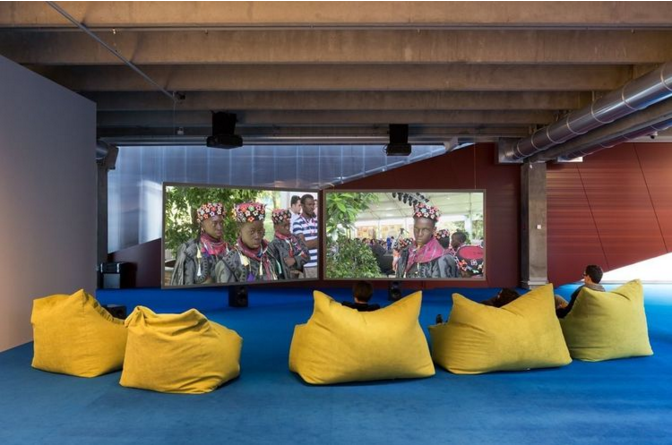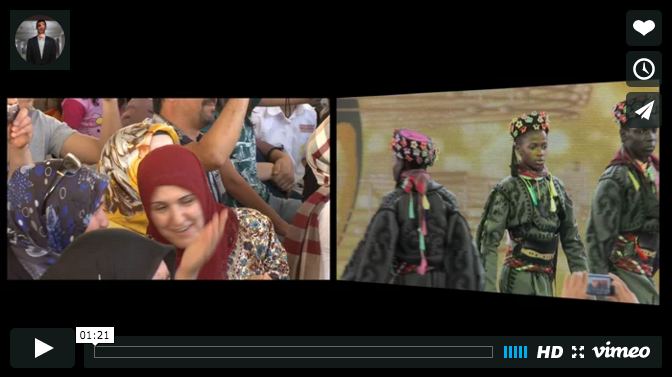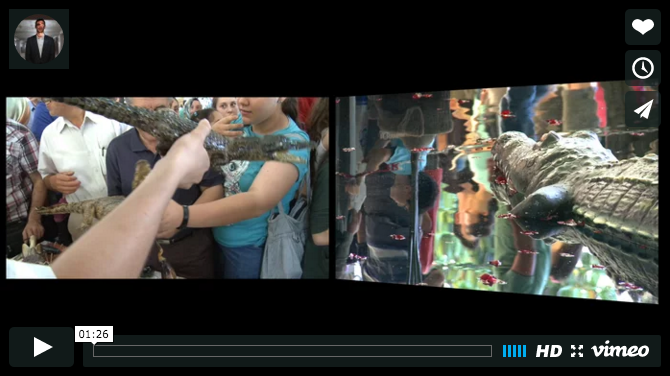Köken Ergun, Mari Spirito, and Yulia Aksenova in conversation about Young Turks
Interview March 11, 2016

Mari Spirito: OK, let’s get right into it: what are your earliest memories of the Turkish Olympics? I remember you mentioning them a long time ago.
Köken Ergun: It was in 2008. I had already been hearing bits and pieces about the Turkish Olympics before then, but a certain performance from that year’s Olympics shared on Facebook caught my attention. A Mongolian student was reading a highly nationalistic Turkish poem in front of a large audience with prominent Turkish politicians at the time (who are still around) and the so-called “religious” middle class.
At first, I thought how much this related to my 2006 work The Flag. That film focused on a schoolgirl reading a nationalist poem at a national day ceremony in a stadium, again to a massive crowd with politicians and army generals. I didn’t think of making a work about it at that time, but more and more clips started coming up on Facebook and other social media platforms. Senegalese students doing folk dances from western Turkey, Thai students performing a rare halay dance from the Kurdish region, an Albanian student singing a famous pop song from the time, you name it.
Among my social circle there was a kind of ironic approach to the Olympics, almost looking down on them. I cannot blame them because some of these clips appeared quite funny and even ridiculous. People would also ask with disbelief, “Are there really so many Turkish schools in the world?” or “When did that happen and how on earth?” You see, we grew up with a certain inferiority complex; a regular Turkish citizen would not have imagined Turkey being able to establish such a huge global network. But obviously there were a large number of people who actually believed in it.
MS: How have your feelings about the Olympics and the Turkish schools changed for you from then to now, after all these experiences and research?
KE: As I became more interested in the schools and how they came into being, I also became aware of the expansionist policies of Turkey. I inquired deeper into the Gülen community, who opened these schools and its complicated links to the Turkish state. By that time the Ergenekon trials had already started in Turkey and we were all hearing more and more about the collaboration of this community with Erdoğan’s government. It became obvious and public that they were working hand in hand in many fields, not only for the global spread of Turkish schools but also in domestic politics. Secular circles were looking at both of them with both remorse and anxiety, so the polarization of the society had already started back then. Amidst this polarized social atmosphere I neutralized myself to all sides and embarked on a wider research about the history of colonialism, charity, missionaries, Turkish foreign policy, World’s Fairs, religion, etc. Some of the books I read during this time are available in a special section of Garage Library now So I saw the Turkish Olympics no longer as an absurdity, but the tip of the iceberg. This is also when I started to correspond with anthropologists and historians. For example I have learned a lot from Ayşe Çavdar, who helped us shape the lecture series for this exhibition. These talks will give us a wider perspective into all these topics that eventually relate to my artwork.
Yulia Aksenova: We are doing this project in a difficult time. Although it was planned in 2013, when nothing presaged political turmoil between Russia and Turkey, today the situation is more complicated, which not only impacted the production process, but may influence the context in which the exhibition, as well as your work in general, is viewed. I think today it is really important to clarify your position as an artist who, on the one hand works with political issues, and on the other retains a critical distance toward them. Is this correct?
KE: Yes, very. Personally, maintaining a certain distance allows me to understand things better. In turn, it also allows me to do something that is more universal and permanent.
The author of any representation, let’s say the artist, has a direct ethical responsibility toward his/her topic and also his/her subjects. This ethical responsibility is not to try to establish total objectivity, which is futile anyway. It is more about knowing your subject close enough to bringing his/her voice to the world in a just way. In order to facilitate this flow, the artist should be very sensitive about the environment—both social and political—in which the subject lives. This can be achieved best by having a subtle approach to all sides of the story; to be able to insert yourself into it first and then hover above it and look at it from far away. That distance should not be too far to detach completely but also far enough to maintain your own personal integrity and perspective. So you can make your own judgment, and not get too attached to the “field” as they say in anthropology— basically your subject(s). This way you can, or at least I can, construct a representation of something that shows the kind of “unexpected” nuances within big narratives.
Politics is a big narrative, for example, and Young Turks is dealing with that kind of big narrative, or let’s say phenomenon. That is what the Gülen community and the Turkish state do in the world. Of course, I am very informed about that but my focus is on the stories or attitudes of individuals who are small parts of the larger phenomenon—individuals who make up this highly complex community. The people who are not heard in general discussions about this phenomenon. We have a lot to learn from them, whether we agree or not.
That’s also why I chose Göran Olsson’s film Concerning Violence that goes with the exhibition. Olsson juxtaposed a key text on post-colonial theory with personal stories. As explosive and interesting as Frantz Fanon’s text may be, it is his own narrative on a huge topic and does not include the voices of the subjects that are written about. We hear him (Fanon) speaking, not them. But his text falls into a better place in Concerning Violence, when actual interviews with the “real” colonizers are shown together with it.
MS: What are your main concerns in relation to neocolonialist expansion, not just by Turkey, but any country?
KE: As long as there is the interplay of power between people there will be expansions and contractions. The Phoenicians were not the first ones to expand back in 900 BC and Turkey will not be the last. And it looks like all expansionist powers or attitudes are following each other, building on top of each other.
The first reaction I had when I actually went to the Turkish Olympics back in 2012 was to think how much it resembled the World’s Fairs of the turn of the century. The interaction between the Turkish audience and visiting students at their country booths was pretty similar to what we can read about the interaction between American fairgoers and Filipino “displays” at the St. Louis World’s Fair (1904) or the French audience and their African “guests” at the Paris Expo (1889). So the expansionist attitude cannot only be blamed on states. It is also the people who endorse it. This is what I wanted to show inYoung Turks.
Also, we are seeing a surge in the expansion of religious communities like the Gülen community. They also build on the history of previous religious communities opening up to the world of the “other.” The Jesuits are an example from Christianity. Ayşe Çavdar also sees historical links between the traveling dervishes of the 14th century and the current global spread of Turkish schools.
YA: In your work you explore the role of ritual and methods of representing the identities of ethnic and religious communities. Could you explain how this project coincides with your research interests? In your opinion, does it manifest a new phase in your artistic practice?
KE: I couldn’t call it a new phase in my practice. I think Young Turks is a continuation of the direction I have had since making earlier works about other social groups, such as the Turkish immigrants in WEDDING and the Filipino guest workers in Israel in Binibining Promised Land. So the same thread continues but the focus is different. The people who are the subject of the work designate the process and shape of the work. They also change me and how I shoot or edit the work.
In time, I got more and more interested in individual stories within the mass. For example in WEDDING I didn’t focus on the individuals but the group dynamics within the mass. I was amazed at what they do and achieve, maybe jealous of them because I grew up as an individual with no such rituals. Then in Binibining Promised Land I included personal interviews into the project, but they were shown on separate monitors. Young Turks is the first time I inserted the personal interviews into the main film.
As far as ritual is concerned, Young Turks is also about a ritual but a new one. The Turkish Olympics is only 13 years old. That might sound too young to call it a ritual, but it could be the beginnings of the making of a ritual. So the audience and I might be witnessing the making of history.
MS: Do you think that the Turkey that exists in the minds of the young students around the world actually exists? Do any of these students who come for the Olympics leave disenchanted?
KE: Almost all of the students I talked to left Turkey completely enchanted. Among the students of Turkish schools in Kenya and Indonesia there is an enormous love of everything Turkish. You also see this in the general public too. Private cars are decorated with logos of Turkey or Turkish university stickers, like those you used to see of Harvard University on the back of cars in Turkey in the ‘80s. The US is not as trendy. Turkish Airlines opens more and more direct flights between İstanbul and African destinations and many passengers connect to the rest of the world from there. This is more than transportation or profit, it means a lot to the African continent. So they embrace Turkey and Turkey acts as “soft power.” This is why we installed a world map in this exhibition, to visualize Turkey’s expansion. But this could be the expansion of any country. In fact, I see this map as a symbol of any expansionist strategy. Maps are important because states or ideologies try to shape the world by making their own maps. Almost no map is objective. There are also books about this in our selection at Garage Library.
Coming back to your question, we should remember that these are teenagers. It’s a relatively early period of life to construct a critical approach. Moreover, these kids are sent by their parents to these schools—most Turkish schools in Africa are top rated—hoping that they will have a bright future. A bright future in Africa mostly means going abroad. Maybe it’s better if I end with a quotation from one of the interviews in the exhibition. This is Erkana speaking, 15 years old, from the Turkish School in Nairobi:
– Have you ever been to Turkey before?
– No, but I’m looking forward to it. I know it will be a good experience for me. As a Kenyan, I’m going to get to know new people outside this world. Most of the time, we only get to know people when they come to the school. But now we are going out of the school so that we will get to know new people. It is nice.
– Do you think you will go to Istanbul?
– Yes. I’m looking forward to that because personally I love Istanbul. It is a great city. Though we know we will be in Ankara for quite some time, I’m praying that we go to Istanbul because the city is beautiful and I like it.
– What do you know about Istanbul?
– I know about the bridge that connects Asia and Europe I’m looking forward to going to that bridge.
MS: You are able to walk a very fine line of balancing multiple perspectives in most of your work, but more so in Young Turks. Is this intentional? Is this something you are conscious of, and if so, how do you do it?
KE: It’s part of me, I guess. I always want to see all sides of everything. That might even be the reason why I do multi-channel films. I like that multiplicity and the ability to see things from different angles. In my personal life, I like to be surrounded by many people, have friends from different walks of life all over the world and compose a life with the interactions I have with all of them. This is probably why I am doing work about social groups, or let’s say social bonding.
As far as the work goes, it just happens naturally too, because any work I do is directly informed by my personality. I always became good friends with the people whom I met during the process of my work. And it usually happens very quickly. I am now almost a Filipino for my Filipino friends around the world, the Shiite community in Istanbul accepts me as one of them—they even gave me an honorary prize at an Ashura ceremony. Even in Young Turks, I became friends with the teachers in the school. I say “even” because they are a relatively closed society and I have to confess that I started the work with reservations about them. Because the Gülen community has interfered with Turkish politics and the judicial system for a long time behind the scenes and they have developed a bad reputation. But I loved the teachers and we spent a great time together outside of filming. We became like normal friends. Only when I met them did I understand that this is not a homogenous community. Not all the individuals in it can be held responsible for all the deeds of the community, good or bad.



Leave a comment